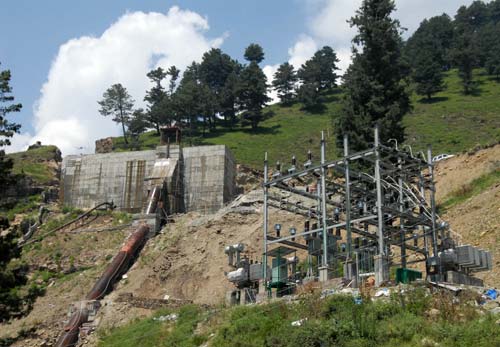At a time when hydel power generation in the state is exclusively NHPC’s baby, a local player has shown a way that Kashmiris are capable enough to built and operate hydel power projects albeit at a mini level. Bilal Handoo travelled to Tangmarg to profile the recently inaugurated Drungi micro hydel power project.
It wasn’t the usual tourist rush which was pouring on the hills of tourist resort Tangmarg on Thursday. For the day, most prominent faces in the state of affairs of Jammu and Kashmir were making their way through pine trees towards the upper hilly region to be the part of the inauguration ceremony of the Drungi micro-mini hydel power project.
In between came Chief Minister, Omar Abdullah, to inaugurate 3×3.33 MW (Approx. 10 MW) capacity hydel project built on Ferozpur Nallah by a local company, Ms Civil Engineering and Constructions.
This mini power project built in Independent Power Producer mode (IPP) in the state took 3 and ½ years to get completed at a cost of Rs 90 crores. “The power project was slated for inauguration in the first week of March itself,” Mudassar Mir, director Ms Civil Engineering and Constructions, told the gathering on the occasion. “But due to landslides, we had to shelve it for another three months for repairing purposes.”
Ms Civil Engineering and Constructions has created a special purpose vehicle, Magpie Hydel Construction Operation Industry Pvt Ltd, to bid for the project located in many parts of the state. The company has a more than 40-years- experience in the construction business and had taken up civil works in power projects like Upper Jhelum, Lower Jhelum, Karnah, Drass and Pahalgam.
Financed by the Jammu and Kashmir Bank, the project, as per Mir, will provide electricity to the local areas of Tangmarg and Gulmarg and prove “highly beneficial for the area especially during the winter season.”
Though the project harnesses only 10 out of the estimated 20,000 MWs hydropower capacity in Jammu and Kashmir, it has been completed much ahead of similar projects taken up in the state.
After the inauguration, Omar called upon the local entrepreneurs to come forward like Nazir Mir and Mudassir Mir, owners of Drungi Micro Hydel Power Project, and take up the projects reserved for locals under the New Hydel Policy.
“My target is to make Jammu and Kashmir power surplus state,” Omar told a gathering of politicians, bureaucrats, officials, and locals, adding, “and strengthens its economy to such a level where from it needs not to plead for central assistance time and again for every development work.”
The power sector was thrown open to private parties in J&K only in 2003 under a revised policy. By then J&K Power Development Corporation (PDC) had identified 44 small and micro power projects and completed the survey in 29 others. In the first go, 10 were allotted after open bidding to the highest bidder (two lakh Rupees per MW) on built, operate, own and transfer (BOOT) basis.
With an aggregate installed capacity of 59.2 MWs, these small power projects were supposed to trigger an investment of Rs 413 crores in energy-starved remote and backward belts – three in Jammu and seven in Kashmir.
For the ten projects, two firms are from outside, four are Srinagar based, two are Jammu based and the remaining two are joint ventures between state units and outsiders. Magpie Hydels, a Srinagar based company has bagged three of the ten projects.
Apart from the newly commissioned Drungi power project in the state, Nazir Mir and his son Mudassar Mir had constructed the 12 MW Athwatoo Hydro Power Project (ASHP) commissioned in 2009, which marked the beginning of private sector’s venture into J&K’s small power projects. The ASHP project was constructed at a cost of Rs 77 crore.
Besides, Mirs are about to inaugurate their third project, a 15 MW Poonch project, which is expected to be completed soon. Poonch project which was originally tendered for 4 MW and later upgraded to 15 MW has also been designed by Magpie.
“It was a dream which finally got fulfilled,” Mudassar Mir says. He had returned to join his family business in 2003 after completing MBA from Fordham University New York. After a stint at their hotel in Tangmarg, Muddasar found himself engaged in power sector after their company won the tender to built the ASHP.
But ASHP was a big plunge for the Company as everybody advised against taking the challenge. “I too was apprehensive at first, but my father’s determination got me started,” Mudassar said.
Like ASHP, Drungi is run of the river type. The project uses water below the mandatory for generating electricity. The company has also taken due care of the environment while constructing the project. “We designed the project is such a way that it causes minimal damage to the environment,” Mudassar said.
“We know this initiative of ours won’t solve power crisis of the state, but will surely act as the change agent.”
















